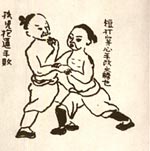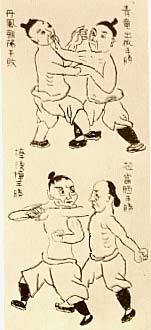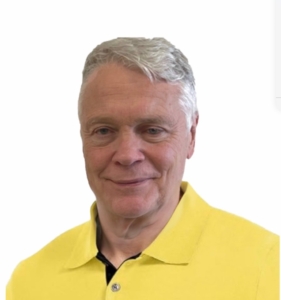Enter The Bubishi
Part 1 – Introduction & Origins
By Victor Smith and Christopher Caile
Editor's Note: This is the first in a three part series on the bubishi. Part 2 will discuss the text and its impact on Okinawan karate. Part 3 will discuss the availability of translations of the text in English, the text's impact on karate today and the current status of research on this text.
 It is an obscure martial arts text written in Chinese. But, it was a most cherished possession of many of the great founders of modern karate — something that was meticulously hand copied and shared among only their most trusted students.
It is an obscure martial arts text written in Chinese. But, it was a most cherished possession of many of the great founders of modern karate — something that was meticulously hand copied and shared among only their most trusted students.
It is called the bubishi.
The bubishi's age and the origin are unknown. Yet, while the text remains a mystery, it is also the only historical written record of martial techniques and theory to have emerged from karate's shrouded past.
Karate, as we know it, became known to the world in the early 20th century after emerging in Okinawa after centuries of secret practice. It was taught publicly for the first time around 1905. Its origins too remain obscure, tangled in a conflicting web of myth and oral tradition — a mixture of native art (te, meaning hand) mixed with Chinese and other fighting traditions.
Karate, as we know it, became known to the world in the early 20th century after emerging in Okinawa after centuries of secret practice. It was taught publicly for the first time around 1905. Its origins too remain obscure, tangled in a conflicting web of myth and oral tradition — a mixture of native art (te, meaning hand) mixed with Chinese and other fighting traditions.
 |
Funakoshi |
 |
Mabuni |
 |
Miyagi |
In the 1930's the first public reference was made to the existence bubishi in the hands of senior Okinawan karate instructors. By this time karate had been introduced into Japan, and Okinawan martial artists had begun publishing books in Japanese to publicize and gain approval for their imported art.
In their writings, both Ginchin Funakoshi (founder of Shotokan karate) and Kenwa Mabuni (founder of Shito-ryu karate) made public what had previously been a closely held secret in the Okinawan arts. It is also said that the founder of Goju-ryu karate, Chojun Miayagi, named his style after a phrase taken from this book. (1)
In 1922 Funakoshi published the first book on karate in Japan, "Ryukyu Kenpo Toudi." Four chapters from the bubishi were included at the end of the book, but the bubishi itself was not named. The bubishi section was also not translated. It was left in its original Chinese style of writing. (2)

In 1934 when Kenwa Mabuni published "Seipai No Kenkyu" (Study of Seipai) the bubishi was named. Mabuni included the drawings from five chapters from Anko Itosu's copy of the bubishi (Itosu had been Mabuni's teacher and is considered the founder of shorin-ryu karate. Itosu first taught karate in public on Okinawa). Interestingly Mabuni dedicated more pages of his book to the bubishi (95, in fact) than he used for the purported subject of the book (79 pages), the kata Seipai.
 Another later text, "Karate, Goju-ryu by the Cat," by Gogen Yamaguchi (founder of Japanese Goju karate), also discussed text. The book included 39 pages from the bubishi (mostly illustrations as shown here) as a separate chapter, but no translation of any of the text was provided. (3)
Another later text, "Karate, Goju-ryu by the Cat," by Gogen Yamaguchi (founder of Japanese Goju karate), also discussed text. The book included 39 pages from the bubishi (mostly illustrations as shown here) as a separate chapter, but no translation of any of the text was provided. (3)
Now available in several English language renditions the bubishi, allows us to enter the world of mystery and possibility that so endeared the text to the founders of modern karate who we revere today.
The Origins
There is no definitive answer to where the bubishi originated, or even who wrote it. In the same light, we cannot even be sure who possessed copies for their own use.
Prior to the 20th century, Okinawan martial artists did not document their arts. Karate was practiced in secret and many teachers were not literate. As a result, what is known of karate and its origin is the product of a relatively recent oral tradition. Thus, it becomes very difficult to prove any source or trace exact history.
In contrast, in China, where martial arts practice had been done in the open, books about self-defense, kung fu systems, exercises and forms (kata) were as common in the end of the 19th century as today. They were also used as a learning tool by many people to learn about empty hand self-defense. (4)
We don't know, however, if the bubishi was written or compiled in Southern China or on Okinawa. We do know it was written in Chinese. It could be a personal notebook of someone trained in White Crane and Monk Fist (Shaolin) kung fu arts. Equally it could be a compilation of martial arts notes from many sources.
We also know that Miyagi Chojun (the originator of Goju Ryu) had a copy most likely copied from his teacher, Higashionna Kanryo. (5)
Patrick McCarthy, the well known martial arts historian and writer, also notes that Mabuni Kenwa was allowed to copy the bubishi from the version owned by his instructor, Master Itosu. McCarthy also writes "I understand there are others," meaning copies in other hands. (6)
All of these copies of the bubishi are not identical. They contain different chapters and the drawings of the self-defense techniques vary somewhat in the strike being used and the target attacked.
In sum, the bubishi is one part of the eclectic synthesis of karate as it developed on Okinawa in 19th and 20th centuries. Having only an oral tradition teachers exchanged knowledge and learned from each other, or visited China to study various Chinese Kung Fu styles. Others, like Funakoshi, sought to preserve the island's fighting heritage by recording and learning many ancient kata.
Thus, the existence of a written fighting arts text (bubishi) was unique and considered important even if the text was not fully understood. As a result, many karate masters meticulously hand copied the bubishi and later published excerpts from it.
What is not known is how much of the bubishi was understood by early 20th century karate teachers, or how much of its knowledge was adopted into the systems they pioneered.
Author's Note
This article was initially authored by Victor Smith, but was edited with contributions of commentary, images and photo captions by Christopher Caile.
Footnotes:
(1) Joe Swift noted to this author that Miyagi had named Gojuryu from the Bubishi has been published in old Japanese karate books as well, and he had a 1942 article named after that precept (Miyagi that is).
(2) It is therefore questionable how many could actually read or understand what was reproduced. The Funakoshi editions, it should be noted, only reproduced written text and not diagrams or drawings. In later reprinted English editions of Funakoshi's 1926 book, "Tote Jitsu," by Masters Publications, 1964, the translator noted that "I was unable to translate the Chinese style" and although several people were consulted, they "were also unable to help." The same segment from the bubishi was later published in the English version of "Karate-Do- Kyohan" published in 1973. The translator noted that he was unable to locate the original source of the material reproduced that was written in the Chinese style.
(3) The chapter titled, "Introduction of Part of bubishi," in Yamaguchi's book contained mostly (35 of the 38 pages) illustrations of self-defense moves and/or diagrams of the body's vulnerable points from the bubishi. The English translation of the book had no translations of the written text.
(4) Fernando Camara, from a lecture recorded at his website (please be aware that this site may no longer be accessible): http://www.geocities.com/Colosseum/Bleachers/6758/hakutsuru_menu.htm
(5) The Higashionna bubishi is mentioned by John Sells in his historical volume, "Unante-The Secrets of Karate." Higashionna may have been illiterate, and thus his version of the bubishi is a topic of some controversy. Was it his own journal, or given to him, possibly in Fujian, a province in China where he studied?
(6) Ancient Okinawan Martial Arts, Volume Two – Koryu Uchinadi.
Victor Smith
Victor Smith is a respected teacher of Isshinryu karate (6th degree black belt) and tai chi chuan with over 26 years of training in Japanese, Korean and Chinese martial arts. His training also includes aikido, kobudo, tae kwon do, tang so do moo duk kwan, goju ryu, uechi ryu, sutrisno shotokan, tjimande, goshin jutsu, shorin ryu honda katsu, sil lum (northern Shaolin), tai tong long (northern mantis), pai lum (white dragon), and ying jow pai (eagle claw). Over the last few years he has begun writing on, researching and documenting his studies and experiences. He is the founder of the martial arts website FunkyDragon.com/bushi and is Associate Editor of FightingArts.com. Professionally he is a business analyst, but also enjoys writing fiction for the Destroyer Universe.
About the Author Christopher Caile

Screenshot
Christopher Caile is the Founder and Editor-In-Chief of FightingArts.com. He has been a student of the martial arts for over 65 years.
He first started in judo while in college. Then he added karate as a student of Phil Koeppel in 1959 studying Kempo and Wado-Ryu karate. He later added Shotokan Karate where he was promoted to brown belt and taught beginner classes. In 1960 while living in Finland, Caile introduced karate to that country and placed fourth in that nation's first national judo tournament.
Wanting to further his karate studies, Caile then hitch hiked from Finland to Japan traveling through Scandinavia, Europe, North Africa, the Middle East and South and Southeast Asia — living on 25 cents a day and often sleeping outside.
Arriving in Japan (1962), Caile was introduced to Mas Oyama and his fledgling full contact Kyokushinkai Karate by Donn Draeger, the famous martial artist and historian. Donn also housed him with several other senior international judo practitioners. Donn became Caile's martial arts mentor, coaching him in judo and introducing him to Shinto Muso-ryu under Takaji Shimizu.
Caile studied at Oyama's honbu dojo and also at Kenji Kurosaki's second Tokyo Kyokushinkai dojo. In his first day in class Oyama asked Caile to teach English to his chief instructor, Tadashi Nakamura. They have been friends ever since. Caile also participated in Oyama's masterwork book, "This Is Karate."
Caile left Japan with his black belt and designation as Branch Chief, the first in the US to have had extensive training in Japan directly under Oyama Sensei. As such, Oyama Sensei asked him to be his representative on visits to his US dojos to report on their status.
A little over a year later, Nakamura, Kusosaki and Akio Fujihira won an epic David vs. Goliath challenge match against Thailand's professional Muay Thai Boxers in Bangkok, Thailand, thrusting Kyolushinkai and Nakamura into national prominence.
Back in the US Caile taught Kyokushinkai karate in Peoria, Il while in college and later in Washington, DC. while in graduate school. Durimg this time Shihan Nakamura had moved to New York City to head Kyokushinkai's North American Operation.
In 1976 when Kaicho Tadashi Nakamura formed the World Seido Karate organization, Caile followed. Living then in Buffalo, NY, Caile taught Seido karate and self-defense at the State University of New York at Buffalo (SUNY Buffalo) for over 15 years where he also frequently lectured on martial arts and Zen in courses on Japanese culture.
Caile moved to New York City in 1999 to marry Jackie Veit. He is now an 8th degree black belt, Hanshi, training in Seido Karate's Westchester, NY Johshin Honzan (Spiritual Center) dojo. In Seido Caile is known for his teaching of and seminars on kata applications. He also produced a 14 segment video series on Pinan kata Bunkai currently available to Seido members.
Caile is also a long-time student and Shihan in Aikido. He studied in Buffalo, under Mike Hawley Shihan, and then under Wadokai Aikido's founder, the late Roy Suenaka (uchi deshi under Morihei Ueshiba, founder of Aikido and was Shihan under Tohei Sensei). In karate, Suenaka (8thdan) was also an in-house student of the Okinawan karate master Hohan Soken.
Having moved to New York City, Caile in 2000 founded this martial arts educational website, FightingArts.com. Twenty-five years later, in 2025, it underwent a major update and revision.
For FightingArts.com and other publications Caile wrote hundreds of articles on karate, martial arts, Japanese art, Chinese Medicine and edited a book on Zen. He also developed relationships with a cross section of leading martial arts teachers. Over the last four decades he has conducted extensive private research into karate and martial arts including private translations of the once secret Okinawan hand copied and passed on Kung Fu book, the Bubishi, as well as an early karate book by the karate master Kenwa Mabuni. He periodically returns to Japan and Okinawa to continue his studies and participate Seido karate events. In Tokyo he practiced (with Roy Suenaka Sensei) in a variety of aikido organizations with their founders – including private interviews and practices at the Aiki-kai Aikido Honbu dojo with the son and grandson of aikido's founder, Doshu (headmaster) Kisshomaru (an old uchi-deshi friend) and his son, Moriteru Ueshiba and in Iwama with Morihiro Saito. On Okinawa he studied Goju Ryu karate under Eiichi Miyazato, 10th dan founder of Naha's Jundokan, and also with Yoshitaka Taira (who later formed his own organization, who specialized in kata Bunkai. While there Caile also trained with Hohan Soken's senior student, Master Fusei Kise, 10 dan as well as with the grandson of the legendary karate master Anko Itosu.
Caile's other martial arts experience includes: Diato-ryu Aikijujitsu and Kenjitsu, kobudo, boxing, Muay Thai, MMA, Kali (empty hand, knife and bolo), study of old Okinawan Shoran-ryu & Tomari body mechanics, study of old Okinawan kata under Richard Kim, study of close quarter defense and combat, including knife and gun defenses, Kyusho Jitsu and several Chinese fighting arts including 8 Star Praying Mantis, Pak Mei (White Eyebrow), and a private family system of Kung Fu.
Caile is also a student of Zen as well as a long-term student of one branch of Traditional Chinese Medicine, Chi Kung (Qigong). As one of two senior disciples of Chi Kung master Dr. Shen (M.D., Ph.D.) Caile was certified to teach and practice. This led to Caile's founding of the The Chi Kung Healing Institute on Grand Island, NY. In Western NY, he also frequently held Chi Kung seminars, including at SUNY Buffalo and at the famous Chautauqua Institution in Chautauqua, NY. His articles on Chi Kung also appeared in the Holistic Health Journal and in several books on alternative medicine.
Caile holds a BA in International Studies from Bradley University and MA in International Relations with a specialty in South and Southeast Asia from American University in Washington, D.C. While in Buffalo, NY he also studied digital and analog electronics.
In his professional life Caile also worked in public relations and as a newspaper reporter and photographer. Earlier he worked in the field of telecommunications including Managing a Buffalo, NY sales and service branch for ITT. He then founded his own private telephone company. This was followed by creation of an electrical engineering company that designed and patented his concept for a new type of low-cost small business telephone system (which was eventually sold to Bell South). The company also did contract work for Kodak and the US space program. Simultaneously Caile designed and manufactured a unique break-apart portable pontoon boat.
Most recently Caile co-founded an internet software company. Its products include software suites with AI capability for control and management of streaming media, such as video and music, an all-in-one book publishing software product for hardcover, eBook and audio book creation and security software for buildings and government use.
For more details about Christopher Caile's martial arts, work experience and life profile, see the About section in the footer of this site.
Search for more articles by this author:






